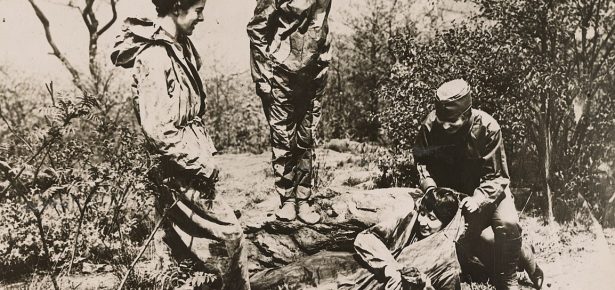
The First World War witnessed the birth of camouflage – both as a word and a developed military practice.
But, while soldiers were disappearing into the landscape, the American feminist writer Charlotte Perkins Gilman was arguing that women also needed to become less visible as part of the war against male oppression.
It sounds like a strange strategy. We often think of feminism as a struggle for recognition – bringing women into the foreground, not hiding them out of view.
But, for Gilman, the main thing holding women back was an excessive focus on their appearance. Excluded from work, women were forced to survive by attracting potential husbands with showy clothes, the impracticality of which reinforced women’s passivity.
In 1915, Gilman complained:
‘The man is required to do something, to show character, action. The woman, in spite of all our rational progress, is still most emphasized as something to look at.’
Like military camouflage, Gilman’s programme for dress reform drew on the science of animal concealment. Researchers had shown that natural selection led to many species blending in with their environments to survive.
These observations led some to regard inconspicuousness as a facet of biological fitness. The attention-grabbing colours that helped animals to attract mates seemed a necessary evil and a cause of degeneration if extended too far.
Similarly, Gilman contended that women’s hypervisibility, enforced by patriarchal society, would render them ever weaker and more helpless until they each resembled ‘a mere egg-sac, an organism with no powers of self-preservation’. In any case, she declared, ‘sex-decoration’ was throughout nature a ‘masculine function’, exemplified in the lion’s lustrous mane in contrast to the subtler grace of the lioness. Gilman called for similar understatement in women’s dress, so that they would appear to men as humans first and sexual partners second.
She envisaged this feminist future in her utopian novel Herland, in which male explorers discover a country of superwomen. The Herlandians’ strength and intelligence is paralleled by their sexual inconspicuousness. Dressed in a ‘sexless costume’, these tall, vigorous people confound the visual cues by which the men are used to recognising women. When the men see some Herlandians climbing a tree, the narrator struggles to sex them:
‘There among the boughs overhead was something – more than one something – that clung motionless, close to the great trunk at first, and then … separated into three swift-moving figures and fled upward . . . They were girls, of course, no boys could ever have shown that sparkling beauty, and yet none of us was certain at first.’
Like camouflage’s disruptive coloration, which blurs objects’ edges, the Herlandians blur the stereotyped boundaries between masculinity and femininity.
Gilman’s feminist camouflage exemplifies the surprising ways feminist politics has interact through history with other, seemingly unrelated cultural trends, in this case, biological and social Darwinism. However, as my book explores in more detail, this interaction was not without problems.
Latest Comments
Have your say!